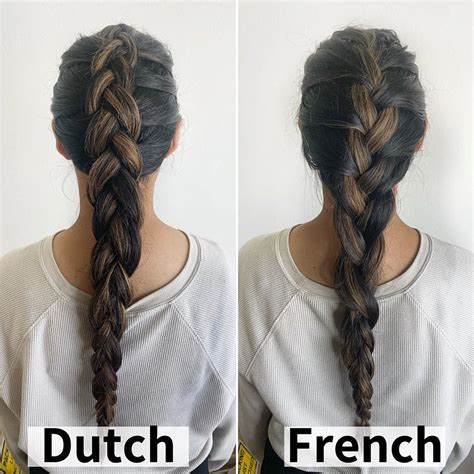Introduction
Braids, an intricate and captivating hair art, have adorned heads for centuries. Among the timeless classics stand two regal braids: the Dutch braid and the French braid. Both exude elegance, versatility, and a touch of allure. In this comprehensive guide, we delve into the intricacies of each braid, comparing their techniques, aesthetic appeal, and suitability for various occasions.

Chapter 1: A Historical Voyage Through Time
French Braid:
- Originating in France, the French braid has graced women’s hair since the 12th century. Its elegant and timeless appeal has made it a staple in cultures worldwide.
Dutch Braid:
- The Dutch braid, also known as the “Inside-Out” braid, emerged in the Netherlands around the 16th century. Its name stems from the Dutch word “vlecht,” meaning “to braid.”
Chapter 2: The Art of Crafting Beauty
Technique:
French Braid:
1. Divide hair into three equal sections.
2. Cross the right strand over the middle strand.
3. Pick up a small piece of hair from the left side and add it to the right strand.
4. Cross the modified right strand over the new middle strand.
5. Repeat steps 2-4 until all hair is braided.
Dutch Braid:
1. Divide hair into three equal sections.
2. Cross the right strand underneath the middle strand.
3. Pick up a small piece of hair from the left side and add it to the right strand.
4. Cross the modified right strand underneath the new middle strand.
5. Repeat steps 2-4 until all hair is braided.
Visual Differences:
- French Braid: Lays flat against the head, creating a delicate and refined look.
- Dutch Braid: Projects outward from the head, forming a raised and voluminous silhouette.
Chapter 3: A World of Versatility
Styling Options:
Both Dutch and French braids offer a plethora of styling possibilities.
French Braid:
– Classic: A simple and elegant braid that complements formal occasions and everyday wear.
– Crown Braid: A headband-like braid that adds a touch of whimsy to weddings and bohemian styles.
– Pull-Through Braid: A variation that creates fullness and texture in shorter hair.
Dutch Braid:
– Side Braid: A statement-making braid that draws attention to a single side of the face.
– Fishtail Braid: A more complex variation that creates an eye-catching and intricate look.
– Crown Braid: Similar to the French, but more pronounced, adding height to the crown of the head.
Chapter 4: Embracing Individuality
Choosing the Braid for You:
The perfect braid depends on individual preferences, hair type, and the desired aesthetic.
French Braid:
- Ideal for: Long, fine hair that requires a sleek and polished look.
- Not recommended for: Short hair that may struggle to hold the braid.
Dutch Braid:
- Ideal for: Thick, voluminous hair that can handle the added volume.
- Not recommended for: Fine hair that may appear bulky.
Chapter 5: Inspiring New Creations
Braided Wonders:
Combining Dutch and French braids can lead to innovative and visually stunning creations.
- Half-Up Dutch Braid: A fusion of a Dutch braid that sweeps into a French braid at the crown.
- Double Braid: Two French or Dutch braids placed side-by-side or interwoven for a dramatic effect.
- Inverted French Braid: A French braid that mimics the look of a Dutch braid by starting with an outside cross.
Chapter 6: Tables of Knowledge
| Characteristic | French Braid | Dutch Braid |
|---|---|---|
| Origin | France | Netherlands |
| Appearance | Flat against head | Raised and voluminous |
| Technique | Crosses over | Crosses under |
| Ideal Hair | Fine, long | Thick, voluminous |
| Best for | Formal events, everyday wear | Statement-making styles, adding volume |
| Styling Inspiration | French Braid | Dutch Braid |
|---|---|---|
| Classic | Yes | Yes |
| Crown Braid | Yes | Yes |
| Fishtail Braid | No | Yes |
| Side Braid | No | Yes |
| Half-Up Braid | Yes | Yes |
| Suitability for Hair Types | Fine Hair | Thick Hair |
|---|---|---|
| French Braid | Yes | No |
| Dutch Braid | No | Yes |
| Double Braid | Yes | Yes |
| Inverted French Braid | Yes | No |
Chapter 7: Frequently Asked Questions (FAQs)
- Which braid is easier to do? French braids are generally easier for beginners due to the overhand crossing technique.
- How long do these braids last? With proper care, both French and Dutch braids can last for several days.
- Can you sleep with these braids? Yes, but securing the braids with a silk scarf or bonnet helps prevent tangles and breakage.
- How can I add embellishments to the braids? Ribbons, hair accessories, and artificial flowers can enhance the beauty of these braids.
- Is it possible to braid wet hair? Braiding wet hair is not recommended as it can stretch and damage the hair.
- How often should I wash my hair after braiding? Washing your hair too frequently can dry out the scalp and hair. Aim for washing every 2-3 days.
Chapter 8: Conclusion
The Dutch braid and the French braid stand as two timeless and versatile hairstyling techniques that have captivated hearts for centuries. Whether you prefer the delicate elegance of the French braid or the voluminous grandeur of the Dutch braid, both offer endless possibilities for self-expression and creativity. Embrace the beauty of these braids and elevate your hair game to new heights.
